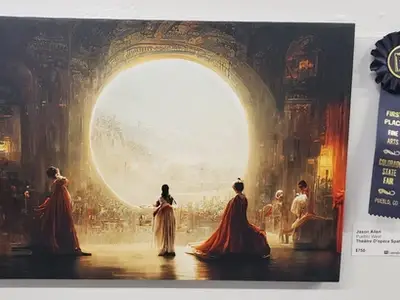
One of the pieces made with Midjourney was selected as the winner of an art competition. Some performers use social media to share their frustrations.
The Colorado State Fair hosted an art competition, and an AI-generated image took first place in the digital category. Jason Allen, the man (or woman) behind the photograph, utilised the photo “AI Midjourney.” After generating a large number of motifs, he selected three to enlarge using the artificial intelligence upscaling system Gigapixel and eventually painted them on canvas.
Hundreds of suggestions before the winning photo was created
Leader of a board game company Allen explains how he spent weeks coming up with the winning “Théâtre D’opéra Spatial” motif: Over several weeks, he came up with a large number of photos and honed his prompts. According to a post he made in the Midjourney Discord, Allen will be releasing his “special prompt” at a later time.
He claims that Allen entered a Midjourney image into an art contest on purpose to make a point about the legitimacy of AI-generated artwork. He included “via Midjourney” after his name while submitting the photo, but he never clarified what it meant.
Allen asks, “Is it usual for artists to discuss their process solely for the purpose of clarification?” when explaining his method. Additionally, Allen utilised Photoshop for roughly 10% of the total. For Allen, the question is not whether or not they approve of the process used to create the artwork, but rather whether or not they approve of the artwork itself.
When the organiser asked how Allen made the artwork, he said, “With a computer,” therefore his designs wound up in the “Digital Art” category. While “via Midjourney” was included, it was not a deliberate inclusion.
In a Discord message, Allen complains that he should have inquired about progress. The judges had access to all the documents and were aware of my submission statements, but by the time I got to see the gallery, the decision had already been made.
The debate over artificially created artworks continues.
After The Atlantic received backlash for including an AI-generated image in a newsletter, Allen’s decision has reignited the debate about whether or not AI art qualifies as “art” and whether or not it might even be preferred to human skill in some contexts.

Twitter has become a venting and fear-mongering space for the creative class. Every time one of these posts is made, thousands of people comment on it and many more people share and back it. The general public seems to think that artistic endeavours can only be accomplished through the application of human skill, hence they are quick to criticise any attempt at artistic expression using artificial intelligence.
According to Allen, he requested a new category for AI art be added, which is being considered by the event’s organisers. So maybe, in the future, we’ll see that materialise,”
























